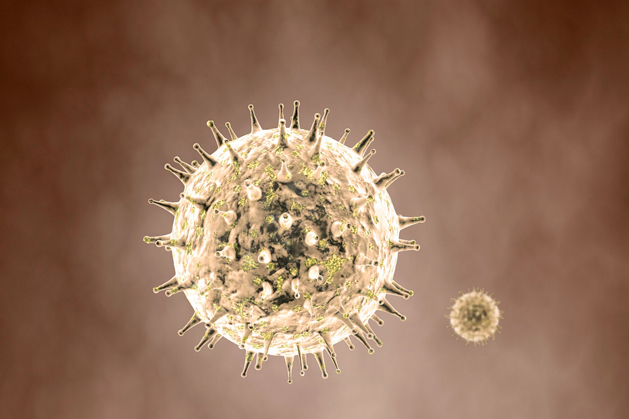
Universal flu vaccine a step closer as scientists create experimental jabs
![]()
Ian Sample, science editor
@iansample
Monday 24 August 2015 16.53 BST
Annual vaccinations could be a thing of the past as scientists have successfully tested vaccines on animals infected with different strains of influenza

3D model of virus particles. Conventional flu vaccines target the “head” of a molecule called haemagglutinin (HA) that sits on the surface of flu viruses. Photograph: Bernhard Classen/Alamy
A universal flu vaccine that protects against multiple strains of the virus is a step closer after scientists created experimental jabs that work in animals.
The vaccines prevented deaths or reduced symptoms in mice, ferrets and monkeys infected with different types of flu, raising hopes for a reliable alternative to the seasonal vaccine.
Doctors hope that a universal flu vaccine would do away with the need for people at risk to have flu jabs every year, and even protect the public from dangerous, potentially pandemic, strains that jump from birds or pigs into humans.
Conventional flu vaccines target the “head” of a molecule called haemagglutinin (HA) that sits on the surface of flu viruses. But because the head of the HA mutates so rapidly, seasonal flu vaccines must be continually re-formulated to ensure they are effective.
During the last flu season, mutations in the HA molecule on one of the most common circulating strains, H3N2, meant that the seasonal flu vaccine offered little protection. Public Health England said in February that the less effective vaccine was likely to have been behind a steep rise in flu deaths.
In two studies reported on Monday, separate research teams describe how they created novel flu vaccines that target the “stem” of the HA molecule instead of the head. The stem of the HA molecule is similar across different flu strains and mutates far less often.
One of the teams, led by Barney Graham at the National Institutes of Health in Maryland, created their vaccine by attaching part of a flu virus’s HA stem to tiny balls of protein. These protein nanoparticles kept the stem intact and made it easy for the immune system to spot once it was injected.
In lab tests, one version of the vaccine completely protected mice and partially protected ferrets from injections of H5N1 bird flu virus, which was fatal in unvaccinated animals. The H5N1 flu strain has killed more than 400 people since 2003, most of whom caught the virus from infected poultry.
“This is very much a test of concept,” Graham told the Guardian. The team, whose study appears in the journal Nature Medicine, now hopes to develop another vaccine that protects against a different group of flu viruses. The first human trials are at least three years away, Graham added.
A second team, led by Antonietta Impagliazzo at the Crucell Vaccine Institute in Leiden, created their own experimental flu vaccine by removing the head of the HA molecule, and tweaking the stem to make it bind to antibodies more effectively.
Writing in the journal Science, the team describes how injections of one formulation of the vaccine protected mice from H5N1 bird flu and the H1N1 swine flu that emerged in 2009. The vaccine was less effective in macaques, but the animals had less severe flu symptoms after receiving the jabs.
“Influenza remains one of the most serious public health challenges, and new therapeutic and preventative solutions are needed,” said Hanneke Schuitemaker, head of viral vaccines discovery at Janssen Infectious Diseases and Vaccines, a company that worked on the vaccine.
“The results highlighted today shows there is potential in the development of a single universal vaccine to protect against all seasonal and pandemic influenza strains,” she added.
Sarah Gilbert, professor of vaccinology at Oxford University, said: “This is an exciting development, but the new vaccines now need to be tested in clinical trials to see how well they work in humans. This will be the next stage of research, which will take several years. So we are still some way from having better flu vaccines for humans.”

